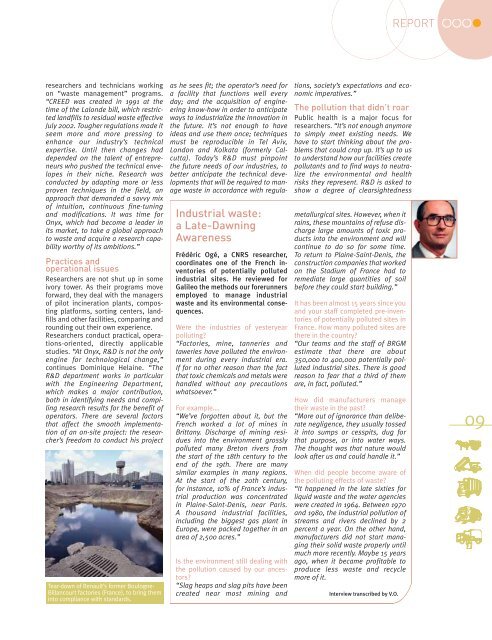What improves waste management? - Veolia Environmental Services
What improves waste management? - Veolia Environmental Services
What improves waste management? - Veolia Environmental Services
You also want an ePaper? Increase the reach of your titles
YUMPU automatically turns print PDFs into web optimized ePapers that Google loves.
esearchers and technicians working<br />
on “<strong>waste</strong> <strong>management</strong>” programs.<br />
“CREED was created in 1991 at the<br />
time of the Lalonde bill, which restricted<br />
landfills to residual <strong>waste</strong> effective<br />
July 2002. Tougher regulations made it<br />
seem more and more pressing to<br />
enhance our industry’s technical<br />
expertise. Until then changes had<br />
depended on the talent of entrepreneurs<br />
who pushed the technical envelopes<br />
in their niche. Research was<br />
conducted by adapting more or less<br />
proven techniques in the field, an<br />
approach that demanded a savvy mix<br />
of intuition, continuous fine-tuning<br />
and modifications. It was time for<br />
Onyx, which had become a leader in<br />
its market, to take a global approach<br />
to <strong>waste</strong> and acquire a research capability<br />
worthy of its ambitions.”<br />
Practices and<br />
operational issues<br />
Researchers are not shut up in some<br />
ivory tower. As their programs move<br />
forward, they deal with the managers<br />
of pilot incineration plants, composting<br />
platforms, sorting centers, landfills<br />
and other facilities, comparing and<br />
rounding out their own experience.<br />
Researchers conduct practical, operations-oriented,<br />
directly applicable<br />
studies. “At Onyx, R&D is not the only<br />
engine for technological change,”<br />
continues Dominique Helaine. “The<br />
R&D department works in particular<br />
with the Engineering Department,<br />
which makes a major contribution,<br />
both in identifying needs and compiling<br />
research results for the benefit of<br />
operators. There are several factors<br />
that affect the smooth implementation<br />
of an on-site project: the researcher’s<br />
freedom to conduct his project<br />
Tear-down of Renault’s former Boulogne-<br />
Billancourt factories (France), to bring them<br />
into compliance with standards.<br />
as he sees fit; the operator’s need for<br />
a facility that functions well every<br />
day; and the acquisition of engineering<br />
know-how in order to anticipate<br />
ways to industrialize the innovation in<br />
the future. It’s not enough to have<br />
ideas and use them once; techniques<br />
must be reproducible in Tel Aviv,<br />
London and Kolkata (formerly Calcutta).<br />
Today’s R&D must pinpoint<br />
the future needs of our industries, to<br />
better anticipate the technical developments<br />
that will be required to manage<br />
<strong>waste</strong> in accordance with regula-<br />
Industrial <strong>waste</strong>:<br />
a Late-Dawning<br />
Awareness<br />
Frédéric Ogé, a CNRS researcher,<br />
coordinates one of the French inventories<br />
of potentially polluted<br />
industrial sites. He reviewed for<br />
Galileo the methods our forerunners<br />
employed to manage industrial<br />
<strong>waste</strong> and its environmental consequences.<br />
Were the industries of yesteryear<br />
polluting?<br />
“Factories, mine, tanneries and<br />
taweries have polluted the environment<br />
during every industrial era.<br />
If for no other reason than the fact<br />
that toxic chemicals and metals were<br />
handled without any precautions<br />
whatsoever.”<br />
For example….<br />
“We’ve forgotten about it, but the<br />
French worked a lot of mines in<br />
Brittany. Discharge of mining residues<br />
into the environment grossly<br />
polluted many Breton rivers from<br />
the start of the 18th century to the<br />
end of the 19th. There are many<br />
similar examples in many regions.<br />
At the start of the 20th century,<br />
for instance, 10% of France’s industrial<br />
production was concentrated<br />
in Plaine-Saint-Denis, near Paris.<br />
A thousand industrial facilities,<br />
including the biggest gas plant in<br />
Europe, were packed together in an<br />
area of 2,500 acres.”<br />
Is the environment still dealing with<br />
the pollution caused by our ancestors?<br />
“Slag heaps and slag pits have been<br />
created near most mining and<br />
tions, society’s expectations and economic<br />
imperatives.”<br />
The pollution that didn’t roar<br />
Public health is a major focus for<br />
researchers. “It’s not enough anymore<br />
to simply meet existing needs. We<br />
have to start thinking about the problems<br />
that could crop up. It’s up to us<br />
to understand how our facilities create<br />
pollutants and to find ways to neutralize<br />
the environmental and health<br />
risks they represent. R&D is asked to<br />
show a degree of clearsightedness<br />
metallurgical sites. However, when it<br />
rains, these mountains of refuse discharge<br />
large amounts of toxic products<br />
into the environment and will<br />
continue to do so for some time.<br />
To return to Plaine-Saint-Denis, the<br />
construction companies that worked<br />
on the Stadium of France had to<br />
remediate large quantities of soil<br />
before they could start building.”<br />
It has been almost 15 years since you<br />
and your staff completed pre-inventories<br />
of potentially polluted sites in<br />
France. How many polluted sites are<br />
there in the country?<br />
“Our teams and the staff of BRGM<br />
estimate that there are about<br />
350,000 to 400,000 potentially polluted<br />
industrial sites. There is good<br />
reason to fear that a third of them<br />
are, in fact, polluted.”<br />
How did manufacturers manage<br />
their <strong>waste</strong> in the past?<br />
“More out of ignorance than deliberate<br />
negligence, they usually tossed<br />
it into sumps or cesspits, dug for<br />
that purpose, or into water ways.<br />
The thought was that nature would<br />
look after us and could handle it.”<br />
When did people become aware of<br />
the polluting effects of <strong>waste</strong>?<br />
“It happened in the late sixties for<br />
liquid <strong>waste</strong> and the water agencies<br />
were created in 1964. Between 1970<br />
and 1980, the industrial pollution of<br />
streams and rivers declined by 2<br />
percent a year. On the other hand,<br />
manufacturers did not start managing<br />
their solid <strong>waste</strong> properly until<br />
much more recently. Maybe 15 years<br />
ago, when it became profitable to<br />
produce less <strong>waste</strong> and recycle<br />
more of it.<br />
Interview transcribed by V.O.<br />
REPORT<br />
09



